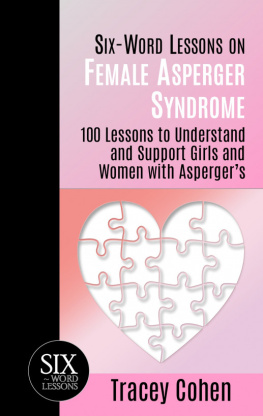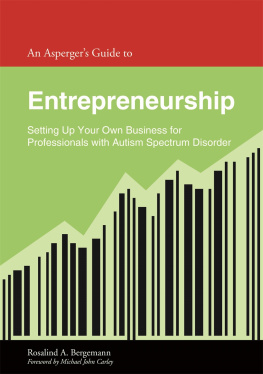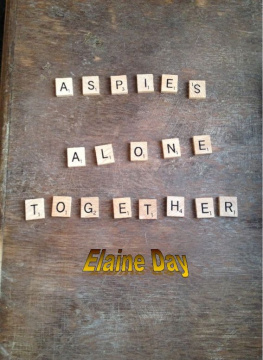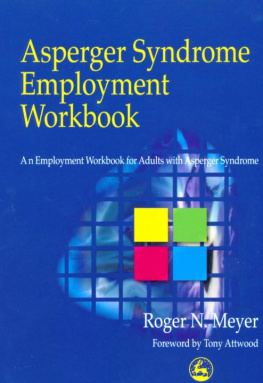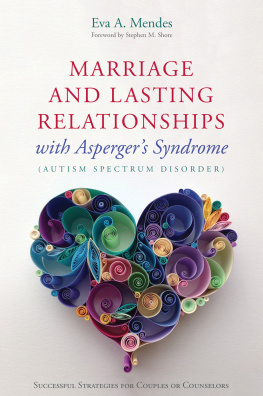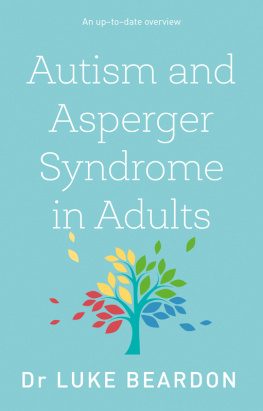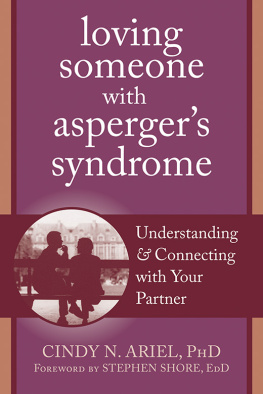
ON FEMALE ASPERGERSYNDROME
100 Lessons to Understandand Support Girls and Women with Aspergers
Tracey Cohen
Published by Pacelli Publishing atSmashwords
Copyright 2015 by TraceyCohen
Smashwords Edition, LicenseNotes
This ebook is licensed for yourpersonal enjoyment only. This ebook may not be re-sold or givenaway to other people. If you would like to share this book withanother person, please purchase an additional copy for each person.If youre reading this book and did not purchase it, or it was notpurchased for your use only, then please return to Smashwords.comand purchase your own copy. Thank you for respecting the hard workof this author.
Limit of Liability: While the authorand the publisher have used their best efforts in preparing thisbook, they make no representation or warranties with respect toaccuracy or completeness of the content of this book. The adviceand strategies contained herein may not be suitable for yoursituation. Consult with a professional when appropriate.
Introduction
I always knew I wasdifferent.
As did my loving mother from the time Iwas an infant.
But we did not understand why, andunfortunately knowledge of Asperger syndrome, especially relevantto girls, was scarce.
Short enough to be read in a day,recommended resources for anyone compelled to learn more, it is mysincere intention that this book serve as a concise, powerful,valuable tool for individuals, families, educators and medicalprofessionals.
I am forever grateful to each and everyfriend, acquaintance and family member who has shown me kindness,tolerance and understanding over the years.
Peace, love and happiness toall.
~ Tracey Cohen
Foreword
I first met Tracey and her mother ather evaluation to determine if she had a diagnosis on the autismspectrum. Tracey is an intelligent young woman and I am so glad sheis sharing her story so that her experiences can help others insimilar situations.
This is a powerful and emotional bookwritten from the first-hand experience of a gifted and talentedyoung woman with Aspergers. She shares her life-long battle todiscover her true self and find answers to the questions she alwayswondered about. The book shares her incredible story from herchildhood through today.
Tracey has put her heart and soul intothis book, and I believe it shows. Her lessons will resonate withmany who read it and will transform lives.
This book is such a valued resource,not only for girls and women who are on the autism spectrum, orbelieve they might be, but also for those who love and care forthem. From teachers, professionals, and parents, to the individualswho are seeking out an Autism Spectrum diagnosis for themselves,this book will provide a unique and powerful insight into what thejourney and struggles have been for Tracey and her family,providing an understanding that I dont believe can be foundanywhere else.
Aspergers Syndrome wasnt officiallyrecognized as a diagnosis until the mid-1990s, over fifty yearsafter autism was identified. Dr. Hans Asperger identified thediagnosis based on behavioral observations of four boys. Even tothis day, there is little research on the differences in male andfemale symptoms, which makes this book so valuable.
For many years, many girls and womenhave often gone unidentified and misdiagnosed. Males and femalesshare the same diagnostic behaviors, but girls and women presentthese symptoms to the world and cope with them extremelydifferently from their male counterparts. Tracey explains thesedifferences in her book.
Tracey has a unique way of not onlytelling her own story, but also explaining Aspergers syndrome andthe challenges she faced, as well as the strength her diagnosis hasgiven her throughout her life.
Her experiences, abilities andperspective on life growing up as an undiagnosed female withAspergers will be appreciated by many who have been in her shoes,or may currently be in her shoes. Her story will also provide agreater understanding to those who work with, love and cherishthese girls.
I believe this book is an essentialpart of providing a better understanding of females on the autismspectrum and is one that everyone should read.
Karen McKibbin
Portland Autism Center, Portland Oregon
March 2015
Acknowledgements
I would like to extend my sinceregratitude to all the noted professionals and leaders in the fieldof Asperger syndrome and autism spectrum disorder. Your work hasprovided me with invaluable insight resulting in a happier,healthier me.
I aspire to do the same for others inthis book which I dedicate with much love to my parents, George andJoan Cohen, my staunch supporters, each in their own uniquelyloving way.
Terminology
Asperger syndrome - an autism spectrum disorder largelydistinguished by significant difficulties in social interaction andnonverbal communication. A neurological disorder, the exact causeof Asperger's is not known but believed to be geneticallylinked.
Aspie - a person who has Asperger syndrome
Neurotypical - a term originating in the autistic community todescribe those who are not on the autistic spectrum.
Figures of Speech - I chose to usefigures of speech (communication that is not meant literally)throughout the book in an attempt to implement humor, flow ofcontent and appeal to the likings of neurotypical readers. Thecontent itself however is not exaggerated in the least. To my aspiereaders I apologize for any confusion and acknowledge that it takesyears of practice to recognize and understand the euphemisms of theneurotypical world. For clarification, please referenceTheFreeDictionary.com and/or contact me directly atruntrace@hotmail.com.
Contents
Do not discount a parentsintuition.
A parents sixth sense should never beignored. Early on, my mother knew there was something not rightwith me, but professionals and family members trivialized herconcerns. Unable to help me with early intervention, she hassupported me through the years and played an integral role in mydiagnosis process. Advocate for your child and trust your instinctsunwaveringly.
Take notice of aversion totouch.
Though generally associated withclassic autism, an infants aversion to touch may be a red flag. Asa newborn, instead of finding comfort in the closeness of beingheld, I would cry, become rigid and push away. Though I have triedmany tactics, I still have trouble with intimacy, including thephysical touch of another person.
Speech is advanced beyondtheir years.
The language of Asperger children tendsto be more complex and formal than age would indicate. As a youngchild, I never babbled but spoke with purpose using minimal wordsto express a need or thought. Though I continually make efforts torefine my speech to be more socially appropriate, left to mynatural tendencies and preferences, little has changed.
Smiles: gifts not givens forall
Signs of a childs ability to properlycommunicate with her environment can begin with a smile or lackthereof. As an infant, I rarely smiled. This natural reflex formost has eluded me throughout my life. A smile for me takes muchwork, and though I strive to achieve a joyful persona, nearconstant anxiety is my reality.
We are literal to afault.
Aspies say what they mean and mean whatthey say. A 3:00 p.m. meeting does not mean 4:00 p.m. or even 3:15p.m. We become agitated and confused when what we are told does notmatch reality. It has taken me a long time to realize that I mustallow for these discrepancies in order to function in ourneurotypical dominated world.
Even small changes can bedevastating.
Next page
